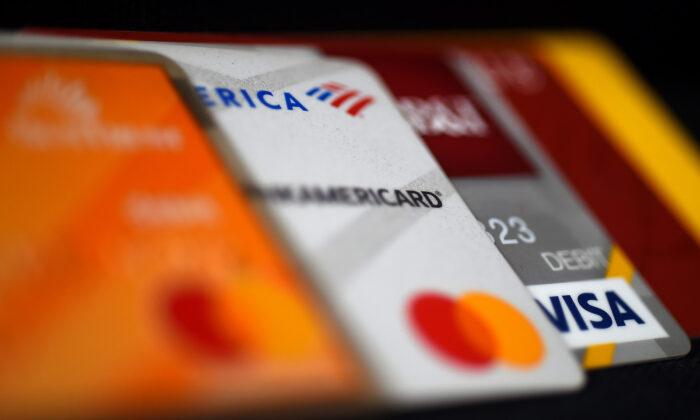Macy’s has said that credit card delinquencies among its customers have risen sharply, while warning that American consumers seem to have hit a rough patch—with more pain likely to come.
Adrian Mitchell, Macy’s chief operating officer and chief financial officer, told analysts on an earnings call on Aug. 22 that the company expected to see consumers under more financial pressure as the Federal Reserve scrambled to contain multi-decade-high inflation by hiking interest rates quickly.
But the fast acceleration of credit card delinquencies among Macy’s customers has been a surprise, he said.
“While we had expected delinquencies to rise as part of our normalizing credit environment, the speed at which the increase occurred for us and the broader credit card industry since our first-quarter earnings call was faster than planned,” Mr. Mitchell said.
He said the jump in delinquencies had a negative impact on Macy’s second-quarter results and led to an increase in future expectations about the amount of bad debt that the retailer will have to grapple with.
Jeff Gennette, Macy’s CEO, said on the call that he sees Macy’s customers coming under greater financial strain—and warned of tougher times ahead.
“They’ve been under pressure,” he said of Macy’s customers, around 50 percent of whom make $75,000 or less. “I think there are some headwinds coming, particularly with student loan debt, that expiration of the loan forgiveness.”
The federal repayment pause on student debt remains in place until Aug. 31.

‘Increased Rate of Delinquencies’
During the call, Mr. Mitchell said that in the second quarter, credit card revenues declined by 130 basis points, or by $84 million year over year, as more customers stopped paying off their credit card debt.“We experienced an increased rate of delinquencies within the credit card portfolio across all stages of age balances,” he said.
While he expressed confidence in the longer-term outlook, that optimism is “tempered by near-term caution” amid broader trends in the industry.
“I think the credit card revenues is an indication of some of the pressures that we’re actually seeing on the consumer,” he said,
Mr. Mitchell said Macy’s is taking steps to mitigate the risk of rising delinquencies, including working with its credit card partner, Citibank, to “surgically” reduce exposure by targeting higher-risk segments.
“But there are things that we cannot control,” he continued, pointing to various headwinds in the broader economy, including the looming end to student debt forgiveness.
“This is about student loans, which we know is going to come into focus in the next month or two [and] auto loans, mortgages,” he said. “So, we just believe that the customer is coming under pressure because these are new realities that they have to continue to deal with as we get through the back half of this year and move into next year.”
Debt-Level ‘Breaking Point’
With Federal Reserve data showing that household debt has soared above $17 trillion, a study by WalletHub indicates that the average American household is now just over $14,000 away from reaching a “breaking point” at which households will be unable to continue paying off loans.The Federal Reserve Bank of New York reported on Aug. 8 that overall household debt ticked up by $16 billion in the second quarter, or 0.1 percent, to $17.06 trillion.
An analysis of the Fed data by WalletHub showed that, at the end of the second quarter, the average U.S. household owed a total of $143,762. That’s a little over $14,000 below WalletHub’s projected “breaking point” for household finances, which is a point at which people can’t keep up with paying their bills.
“Based on our analysis of debt during the Great Recession, the average household is about $14,339 away from truly having to worry about defaulting,” Jill Gonzalez, WalletHub analyst, told The Epoch Times in an emailed statement.
She explained that the “breaking point” for household debt level sustainability is based on a range of factors, including the debt-to-income ratio, the household’s disposable income, the interest payments, and credit utilization.
“Basically, we’re taking into consideration everything that contributes to the household’s total debt and pinpointing when this debt is no longer manageable,” Ms. Gonzalez told The Epoch Times.
The Fed data showed that much of the increase in second-quarter household debt was driven by a jump in credit card balances, which for the first time ever surpassed $1 trillion.
“Credit card balances saw brisk growth in the second quarter,” Joelle Scally, regional economic principal within the Household and Public Policy Research division at the Federal Reserve Bank of New York, said in a statement.
Credit Card Deliquencies Rise
Credit card delinquencies are at an 11-year high, as measured using a four-quarter average, the New York Fed data showed.However, the quarter-to-quarter trend appeared less alarming, with New York Fed researchers noting in a blog post accompanying the release that despite the increase in credit card delinquency rates, there don’t appear to be many signs that American consumers overall are experiencing financial distress.
“Despite the many headwinds American consumers have faced over the last year—higher interest rates, post-pandemic inflationary pressures, and the recent banking failures—there is little evidence of widespread financial distress for consumers,” the analysts wrote.
Deeper In The Hole?
In the first half of the year, American households managed to pay off over $300 billion in debt, but data from last year suggest they could still end the year deeper in the hole.“Through the first two quarters of 2023, U.S. households have paid off roughly $310 billion in debt, including $170 billion during the second quarter. That’s the good news,” Ms. Gonzalez told The Epoch Times in an emailed statement.
“The bad news is that U.S. households paid off more debt through the first half of 2022, when you adjust for inflation, and we ended 2022 with $328 billion in more debt than we started with,“ she added. ”Based on the latest statistics, there’s no reason to think 2023 won’t be the same.”
Another highlight from the New York Fed report is a decline in student loan balances by $35 billion, to $1.57 trillion, with analysts attributing part of that to the Biden administration’s student loan forgiveness program.
“American consumers have so far withstood the economic difficulties of the pandemic and post-pandemic periods with resilience,” New York Fed analysts wrote in the blog post. “However, rising balances may present challenges for some borrowers, and the resumption of student loan payments this fall may add additional financial strain for many student loan borrowers.”
The New York Fed report also showed that auto loan balances rose by $20 billion, to $1.58 trillion, in the second quarter. Like credit card delinquencies, auto loan delinquencies also rose in the second quarter.
Around 114,000 American consumers had a bankruptcy notation added to their credit reports in second quarter, which is slightly more than in the previous quarter, according to the Fed data.







